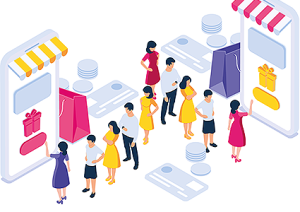Greg Phillips, CEO at Dee Set Group, shares insights into the retail realm of FMCG
From warehousing and merchandising to data collection, Dee Set Group offers brands end-to-end services and actionable insights. CEO, Greg Phillips, places integrity and honesty at the center of everything his world-class, data-driven company does, exploring new ideas and growing from the energy and feedback from customers and colleagues.

“Firstly, Dee Set is a supply chain business, effectively moving products and point of sale into all the major retailers in the UK. The second element is people services. We work on behalf of retailers and brands, putting colleagues in store, every day of the week, in multiple retailers, working in categories that are typically non-core to the business, such as high-level SKUs and health and beauty. Lastly, the third real growth area for us surrounds data and technology, and we are now selling software as a service to our existing partners, which is something we are looking to ultimately scale globally,” Greg explains.
Retail Merchandiser sat down with Greg to get the inside track on the current state of retail, and his predictions for the year ahead. “We’ve seen another recent interest rate rise,” he begins, “which will start to impact people more and more. While inflation seems to be gradually coming down, the cost of living is a challenge and prices are massively important to consumers.
Pricing is key
“As a result, we are seeing some counter activity, such as shrinkflation, which is when brands reduce package sizes for example. The reality though is that retail has always been a high-volume, low-margin game. There is a very limited amount of profit to be made between retailers and brands, so pricing wars are increasingly common. Suppliers are under real pressure from inflationary forces, and yet, the consumer requires increasingly more for less. The pound is becoming more and more stretched, and the retailer is caught in the middle, still trying to make a profit and do a good job.
“We work with several grocery stores and FMCG products. While grocery products, as necessities, are fairly stable in terms of spend, retailers dealing with more discretionary consumer products will find it very tough. People are trading down, and as a consequence, we are seeing the market shares change. Morrisons, for example, dropped out of the big four for the first time. Meanwhile Lidl and Aldi’s Christmas sales were strong. Retailers are looking to own-brand items, as consumers increasingly trade down from branded favourites. Pricing is key, and retailers are examining cost and efficiency. Data and technology play into that, and particularly, in terms of how they can be used to ensure the right products are in the right store, at the right time,” he highlights.
Retailers are having to adapt in response to current economic uncertainty, and Greg elaborates on a particular behaviour. “One response we are seeing is retailers outsourcing large parts of their stores, and effectively acting as landlords with concession arrangements. It’s in the brands’ interest to take on that risk and drive the space. We are seeing whole categories of stock effectively outsourced. A third-party supplier will be responsible for the range, getting it into store and even merchandising the products. While the retailer decides on their proposition, what they think their customers want, and a space strategy for their stores, in reality, they are de-risking the stock, and to a large extent, the sales risk. The risk is pushed back onto either the concessions or the brands themselves.”
The human element

Indeed, keeping pace with the current climate and innovating accordingly is essential in the ever-changing world of retail. As Greg elaborates: “In terms of innovation, the obvious sweet spot everybody is looking for is really useful tech spend. Over the last five or so years, while the prospect of genuinely innovative tech seems to have been on the cards, in reality, robots roving aisles, among other concepts, have never really landed. However, the ability to make a difference whether through efficiency or driving better sales, also needs to be accepted by the consumer. If people are going into a physical store, you have to provide a point of difference. It’s pointless going into a store and having an online experience.
“In physical retail, the human element will remain important to people. There has to be an almost experiential element that still attracts people to a physical store. Retailers are heavily invested in terms of real estate, and the big multiples particularly so. They have got to drive footfall to those locations. Getting a balance between the human and the machine will win the day.
Data driven
“I think there is a sweet spot to be found. More and more people are conscious that data and tech can split opinion. Take Amazon Go stores, for example. Customers walk in, purchases are automatically charged and then they walk out. You don’t speak to anyone, and there are no queues or checkouts. Some people think it is phenomenal, others, not so. People can be wary of innovation, such as facial recognition. The personalization of data presents a huge opportunity, but equally, it presents a real risk too. A softer, targeted approach can be more effective.
“While there is huge opportunity in data, trust is quickly eroded if there is a material breach or data isn’t protected in the right way. It’s very high on every organization’s agenda, ours included. There is an enormous responsibility. Ransomware is increasingly sophisticated. As such, it’s crucial to protect your own systems and integrity, but also the data you acquire. I think that agenda will become more and more significant.
“Everyone is looking for that little bit of tech or data that will fundamentally give them an advantage over the competitor. A considerable amount of money has been wasted in this way. While there will always be an element of trial and error, I still don’t think we have seen as monumental a change in stores as perhaps we might have expected say four years ago. While we have self-service checkouts and a few other innovations, very few have been mass adopted in reality. Technological advancements need to deliver more than face value; material difference is what business models need,” he confirms.
Indeed, Dee Set uses multiple data sets to advise both retailers and brands on potential lost sales value, on opportunities, and where there might be gaps in ordering processes or stock. “We are pretty involved in shelf edge activity,” Greg continues, “having developed image recognition to replace physical stock checks. A picture of a fixture can be used to create a data set, which can, in turn, be interrogated, enabling the retailer to see what is on the shelf, what is out of stock, and whether sales are going to plan. This type of process drives efficiency, and ultimately, sales.”
Collaborative supply
As we bring our conversation to a close, Greg is keen to elaborate on a topic he considers pertinent to the future of retail. “I think transport collaboration will, at some point, have to come to the fore. We currently have the bizarre scenario where single deliveries from Asda, Tesco and Sainsbury’s, for example,
will all arrive within an hour or two of each other, delivering to three different houses in the same street. We have to find a smarter way to fulfil orders without duplicating mileage, labor, and energy.
“The supply chain should be seen as an opportunity for collaboration rather than as a competitive advantage. In the future, there has to be a better way to syndicate deliveries that meets the sustainability and labor agenda. It’s hugely inefficient as is, and would be in everybody’s interest to find an alternative, and potentially, not just in terms of home delivery, but infrastructure, warehousing and logistics, as a whole,” he concludes.
